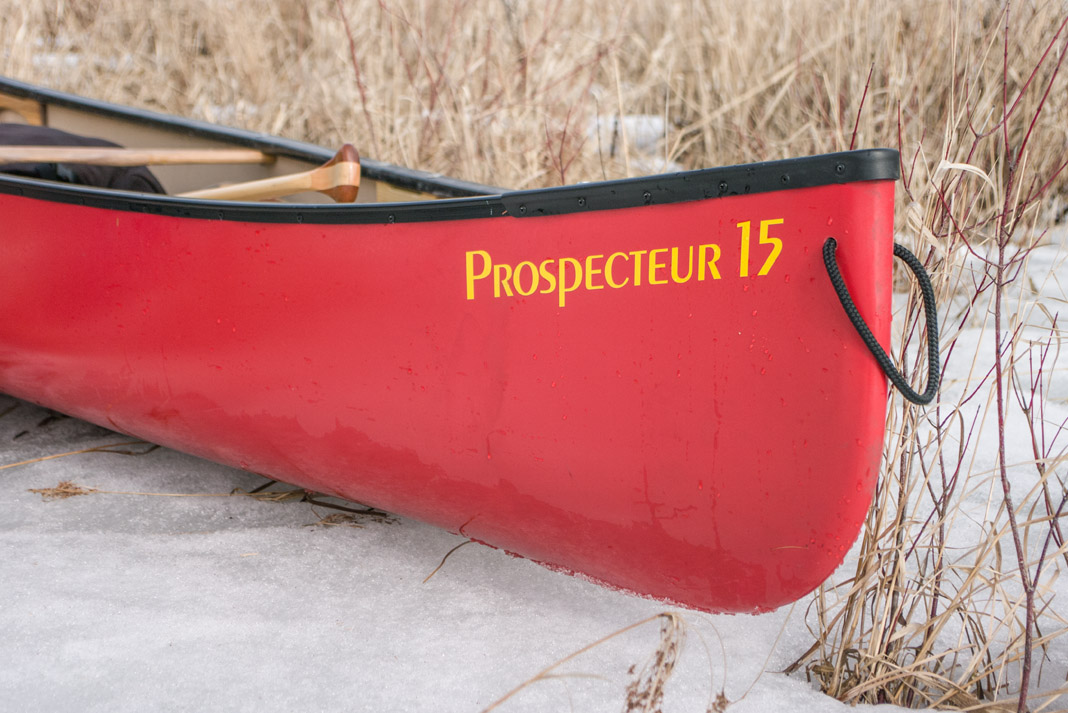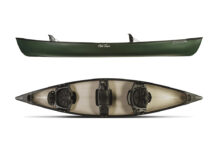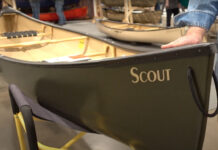This past summer Esquif Canoes added the 15-foot Prospecteur 15 to its lineup alongside its popular Prospecteur 16 and Prospecteur 17 siblings.
Side-by-side, the new 15 looks a bit more like a chubby trick pony than the classic workhorses of the North, yet the whole Prospecteur fleet shares the same classic lines. As they should—each was originally inspired by the original Chestnut Canoe Company Prospector.
Our little 15-foot tester is a full 12 inches shorter than Esquif’s 16-footer, but it still boasts the same 35-inch width, 2.75-inch rocker, and 14.5-inch depth. There’s an optical illusion at play here, because it’s shorter it looks wider, but it’s not, we double-checked.
The family ties don’t end here. In fact, Esquif’s new Huron 15 canoe is pulled from the same mould as the Prospecteur 15. The Huron is then trimmed down two extra inches to a depth of 12.5 inches.
Esquif Prospecteur 15 Specs
Length: 15’
Width: 35”
Weight: 60 lbs
MSRP: $1,900 USD / $2,115 CAD
www.esquif.com
Being able to get two boats from the same mould was always part of the plan, says Esquif Canoes owner Jacques Chassé.
He says the Huron’s lower profile trims off eight to 10 pounds and makes it easier to paddle in breezy conditions.
A small canoe with high-performance and easy maneuverability
Given the choice, however, you already know what we’ll probably take. For backcountry lake and river travel, we’ll take the Prospecteur every time. Even when we try and go light for a weekend, by the time we load up cameras, Dutch ovens, dogs and coffee presses we need all the freeboard we can get through rapids and chop.
So you’re probably wondering why the world needs another Prospector. We asked Chassé the same thing. “Our Prospecteur 15 is for people who are not going on long expeditions but want performance on a smaller platform. It’s easier to maneuver, and easier to load and unload,” he said.
Shorter boats have been gaining popularity in North America over the last decade as vacations and paddling trips are chunked up into shorter blocks of freedom.
Smaller crafts are also particularly popular with Esquif’s European customers, according to Chassé. But, he says, the final decision to add a 15-footer to the Prospecteur line was largely based on the success and popularity of Esquif’s playful 14.5-foot Pocket Canyon.
As much as we love the highly rockered Pocket Canyon, it’s not everyone’s cup of chai. It’s more a charge-toward-eddies, play-the-river kind of tripper. When we loan the Pocket Canyon to friends we watch from the dock as they zigzag off into the distance. We warned them.
The 15-ft canoe that is perfect for any canoe trip
The Prospecteur 15 is a much better all-arounder. If you’ve paddled a Chestnut-inspired Prospector before—who hasn’t?—you’ll be familiar with what to expect in terms of reliable performance. Performance, but not too much performance. It’s a boat more willing to back ferry than the Pocket Canyon. Lakewater paddlers can keep it straight. Goldilocks says, it’s just right.
This chubby-at-the-yoke little Prospecteur boasts ample room for tandem weekend excursions. When we began lining up our gear we realized keeping the width of the larger models keeps blue barrel users happy.
We can drop two in side-by-side. Except for the way the seats and yoke spacing comes installed it isn’t a super efficient use of space—the barrels only fit behind the yoke but are too close the stern paddler’s knees.
Esquif Canoes’ Prospecteur 15 can be a tandem or solo canoe
The bow and stern seats are set too far in from the ends of the boat, at least more than seems necessary from a gear management perspective.
Chassé says he wants to offer bow paddlers a comfortably wide area for kneeling. Consequently, to trim the boat properly the stern seat also needs to be closer to the center point. Which is why there isn’t room for our blue barrels.
This is an easy DIY fix. Moving both seats out eight inches would still provide the bow paddler more width than most Prospectors and still offer lots of forward legroom. This bit of cutting and drilling could actually open up room for four barrels. Four barrels in a 15-footer, we’ll take it.
Before you go moving seats around willy-nilly first consider if the Prospecteur 15 is your ideal canoe for solo trips. Or paddling solo with a young child in the stern seat facing forward. For which the seats are fantastically located for paddlers and gear.
Esquif Canoes’ classic T-Formex canoe
The Prospecteur 15 is made of Esquif’s proprietary T-Formex, a material that looks, acts and feels a lot like Royalex. We’ve written a great deal about T-Formex over the last few years but here’s the Coles Notes version.
T-Formex is glossier, slipperier and seems more abrasion resistant than Royalex. You can buy T-Formex. Just like old Royalex, T-Formex is manufactured into sheets sandwiching a foam core between ABS plastic and another outer top-secret layer Chassé won’t disclose.
T-Formex can be used in the same manufacturing stations Royalex canoes were made in. So workshops formerly producing Royalex canoes can now produce T-Formex canoes. To date, Wenonah Canoe is the only other brand using T-Formex, according to Chassé.
The Prospecteur 15 comes with Esquif’s standard outfitting and canoe seats
Even if you don’t geek out on material composition, still there’s no denying the shiny red T-Formex hull of the Prospecteur 15 looks and feels good on the water. It’s typically trimmed with Esquif’s standard outfitting including vinyl gunwales, webbed seats, and a comfortable standard-issue yoke.
One thing we didn’t like is the way the vinyl deck plates only sort of cover the little carry thwarts. The vinyl edges underneath dig into our hands when bombing the canoe to the water’s edge. We’d upgrade to the optional ash trim because it looks and feels better.
On the first spring-like days of the year, Paddling Magazine staff are already embracing early season paddles in the Prospecteur 15. We’re exploring all the open creeks and playing the pre-runoff rapids.
Our dreams for what the paddling season has in store for our littler loaner Prospecteur 15 are big—long weekend camping trips, river runs and afternoon play dates, either solo or tandem. It’s small, but this pony is mighty. Not too big. Not too small. Just right to go right now.
This article was first published in Issue 53 of Paddling Magazine. Subscribe to Paddling Magazine’s print and digital editions, or browse the archives.











Thanks for the great review this is exactly what I was looking for! One question- does the he P15 have reasonably good glide?